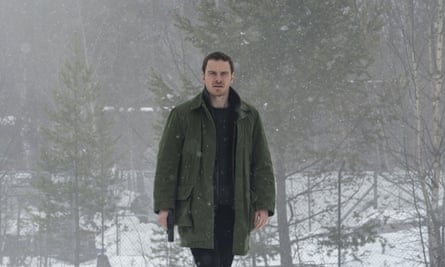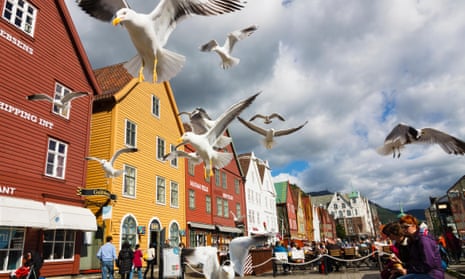Bergen, with its protected historic waterfront and romantic, low-hanging mountain mists, is quite used to being packaged for foreign consumption. Long sold as “the gateway to the Norwegian fjords”, the Viking port is an established stop-off for Nordic cruises and, since the recent international literary boom in Scandi-noir fiction, it also finds itself a big draw for fans of the bestselling crime genre.
Some of its surrounding geographical features have become synonymous with gruesome fictional deaths, largely thanks to the enormously successful Norwegian writer Jo Nesbø. And Bergen’s streets, with their processions of hooded quilted jackets, zipped against the rain, now say only one thing to most modern tourists: “murder”.
The release this weekend of the mega-budget thriller The Snowman, a film starring Michael Fassbender and based on the seventh book in Nesbø’s detective saga, should really mean that the city is bracing itself for another icy blast of association with grim homicide. After all, much of The Snowman was shot on location in and around Bergen and the popular Vidden hiking trail between the Ulkriken and Floyen mountains is the scene of one of the horrific murders detailed in the book.
Yet this weekend, the people of Bergen are actually busy celebrating the advent of an entirely different cultural landmark. Their gleaming new Kunst Musikk Design (art, music and design) faculty building, which opened its doors to students four days ago, is a key part of a concerted national bid to put Bergen back on the European cultural map. The aim is to be recognised as a destination for more than just stately Saga cruise daytrippers or devotees of BBC4’s hit Scandinavian dramas. Backed by Norwegian government funds, the country’s second city is pushing for renewed status as an international centre of creative excellence, able to attract students and top artists from around the world. So the founding of this £100m home for just 350 arts students at a time is a deliberately lavish strategic move.
Applicants from abroad, Frode Thorsen, the dean at KMD, promises, will be welcomed with open arms. Already about one in three of those who receive doctorates are foreigners and some are even funded. Most universities in Norway are state-owned and fairly heftily endowed. Students are supported by the kind of loans and grants that would astonish British freshers. Tuition fees are covered by the government and those studying for a PhD at Bergen University are paid employees. What’s more, much of the teaching is done in English.
Last week, Britain’s Turner prize-winning artist Jeremy Deller was one of the high-profile guests invited to mark the opening of the building, now formally absorbed into Bergen University. Talking to a central hall full of students and lecturers about his work, ranging from his re-enactment of the Battle of Orgreave during the miners’ strike to his “bouncy castle” Stonehenge, Deller emphasised the idea that an artist can bring their work to the public in a variety of forms. “I haven’t really done any work that is conventional art for a long time now. Everything changed when I realised I could work with people, with communities, instead,” he said.
It is a particularly appropriate message for this new building, which has been designed by the acclaimed Norwegian architects Snøhetta specifically as a home for multi-displinary collaborations. The idea behind the KMD building, an amalgam of six schools previously scattered across the city, is that sculptors and ceramicists should be able to work right alongside fine artists and fabric designers. It is interactions like these, said project manager Astrid Renata Van Veen, that may spark new ways of thinking: “These encounters cannot be forced by an architect, of course, but you have to create spaces where these things might happen, to find ways for students to see each other and see their work.”
Indeed, the logo Deller has created for the opening celebrations shows an octopus deftly juggling several musical instruments, a paintbrush, a camera and knitting needles; a different artistic tool in each tentacle.
The first school of art was established in Bergen in 1772 and, while there is some regret about leaving the old faculty buildings in the city centre, the big investment in the new site, coupled with the multi-disciplinary dream, seems to have won over most of the teaching staff.

For the vice-dean, Professor Anne-Helen Mydland, herself a former art student in Bergen, the value of artistic effort is philosophically closely linked with a political commitment to promoting democracy. She believes that by working together, across the disciplines, the arts stand a better chance: “Even in Norway, art is always fighting for itself. Art is about allowing new voices to be heard and it is always a struggle to communicate how important that is. And, with everything going on in the world now, it has never been more important.”
So, while British art schools and university faculties are wondering how to cope with a future outside the European Union, Norway, also an EU refusenik, has been quietly orchestrating a plot twist worthy of one of Nesbø’s detective stories. A stealthy way to survive in the choppy seas of international markets, the government believes, is to use part of its vast and continuing national income from North Sea oil (£1,240bn since production started in the 70s) to position itself at the vanguard of international artistic thinking. Now, on the back of the current popularity of Scandinavian style, the new art school will be using some of these oil funds to remind Norway’s larger neighbours, including Britain, that there is more to the country’s creativity than sleek chairs and cosy rugs.
And the KMD is just one part of the Norwegian investment programme in the reputation of Bergen. As well as a planned new home for the city’s renowned music school, The Grieg Academy, to go up next door to the new arts faculty in Møllendal, Bergen already has a pristine new airport and is in the middle of constructing a light railway system. All this, despite the fact the entire metropolitan area only has a population of 420,000.
Back in the 13th century, Bergen was Norway’s capital, before Oslo overtook it in the 1830s. Sitting at the centre of a lacy network of inlets on the west coast of the country, the Vikings first spotted its potential as a naturally sheltered harbour. But Bergen’s historic significance in Europe chiefly dates from its glorious period, running until the 16th century, as one of the cities of the powerful Hanseatic League, the trading federation established around the Baltic Sea and northern Europe.
Since then, several fires have reduced the size of the city’s most recognisable bit of visual branding, the attractive waterfront Bryggen district, a world heritage site recently crossed by the urgent feet of Fassbender as detective Harry Hole. Whatever the critics may say about The Snowman, it will doubtless attract a fresh wave of tourism to this part of town.
But perhaps the cultural attraction that best sums up the way Bergen now sees itself is a place that has already been pulling in the tourists for decades: the hillside home of Edvard Grieg, the composer of the Peer Gynt Suite.
For, although that other Norwegian cultural giant, the playwright Henrik Ibsen, author of Peer Gynt, once worked as a stage director in Bergen, it is the mighty reputation of Grieg, born there in 1843, that looms over the city, both metaphorically and literally. A visit to the villa in Troldhaugen that he lived in with his wife, the singer Nina Grieg, until his death in 1907 is charming enough. But what really stands out is the way the Griegs used their small home, slightly out of the way as it was for their fellow city dwellers, as a crucible of artistic and social activity. It was frequently full of musicians and regularly used for concerts, its bare wooden walls chosen for the best acoustics and its partitioned ground-floor rooms hosting impromptu performances: a perfect model for what the city of Bergen now hopes to become in northern Europe.

Comments (…)
Sign in or create your Guardian account to join the discussion